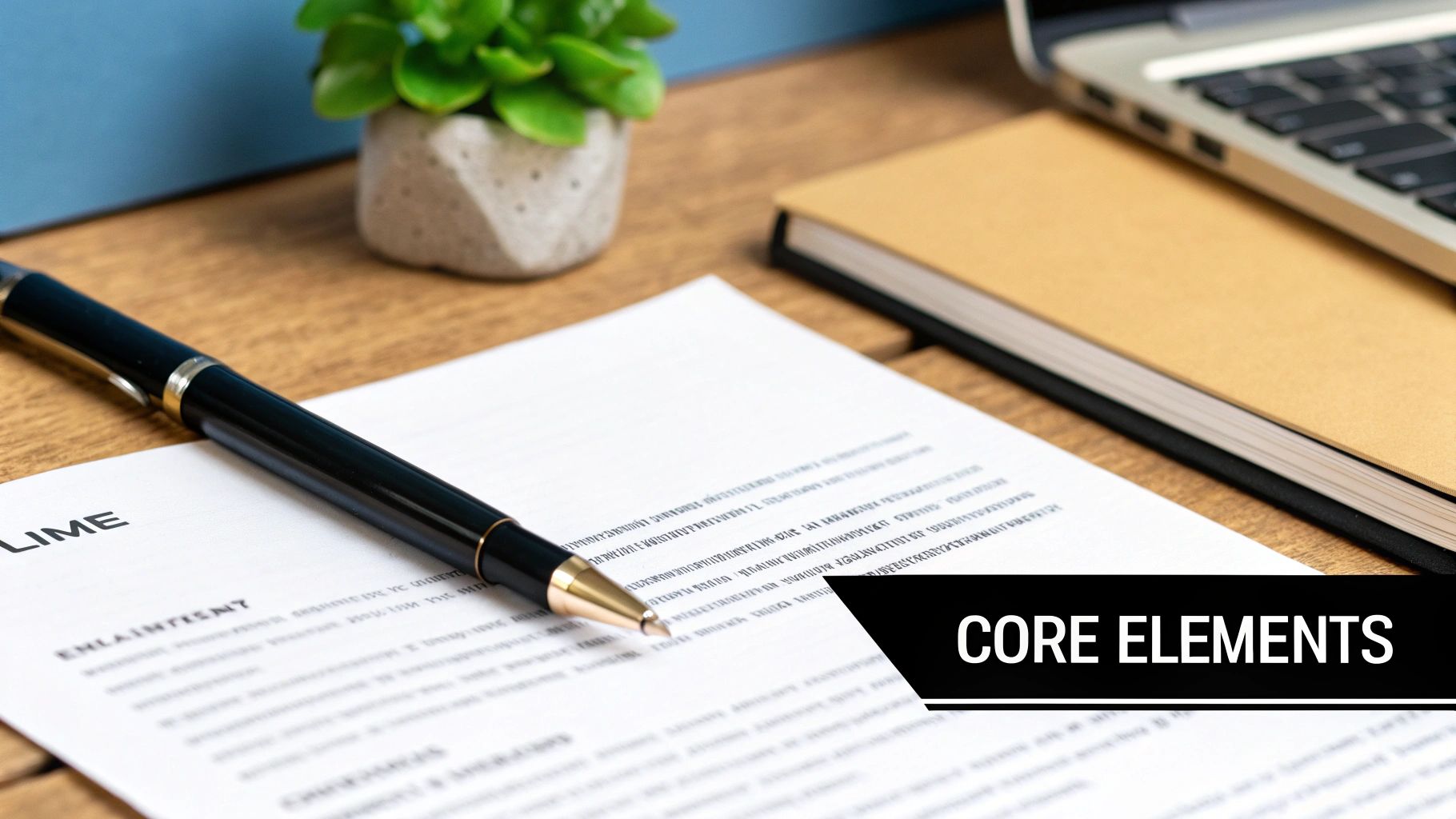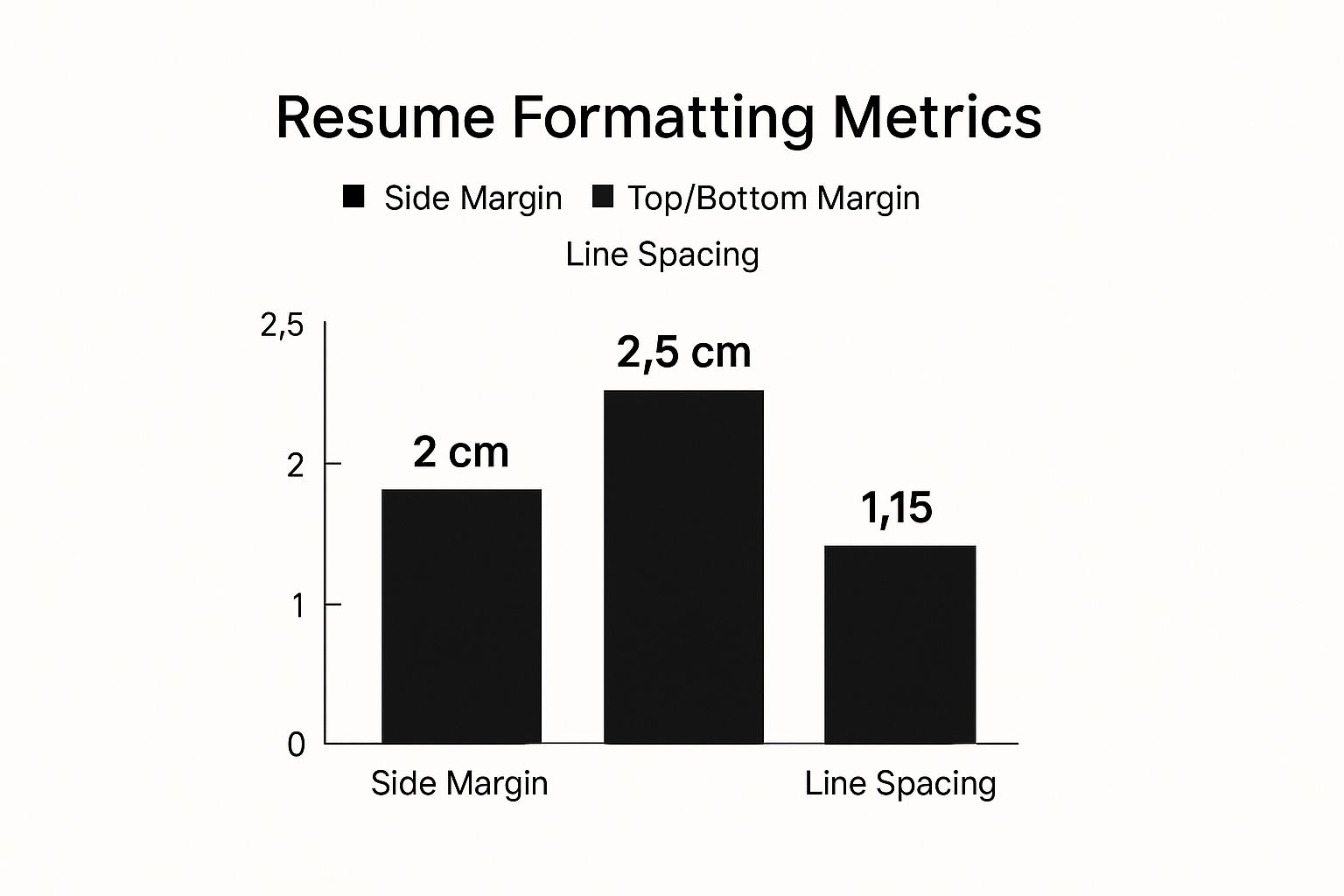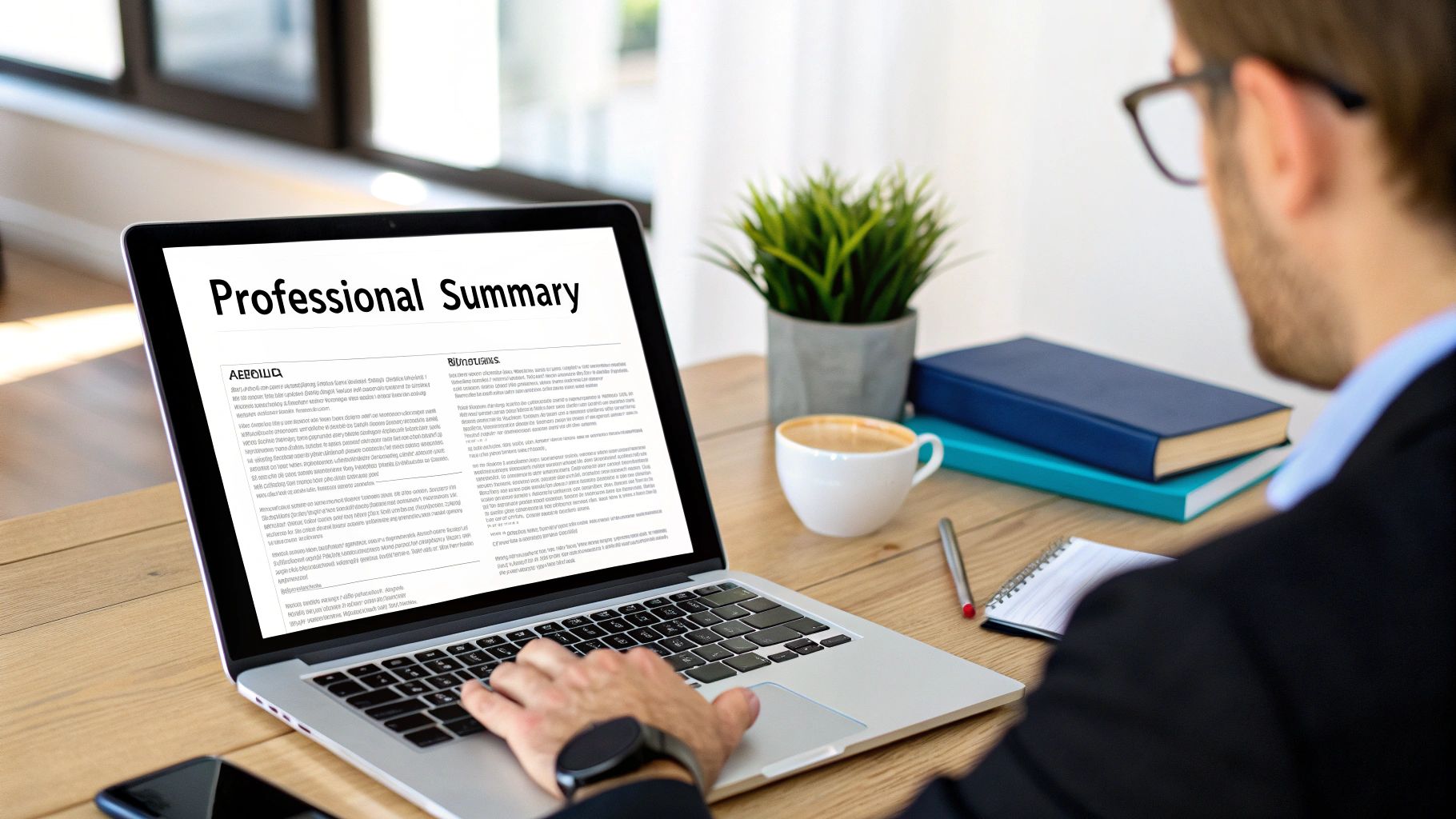When preparing a resume for the Australian market, the standard is a clean, professional document, typically between two to four pages. The prevailing format is reverse-chronological, which means you list your most recent role at the top and work backwards. This structure allows a hiring manager to quickly assess your latest experience and capabilities.
Understanding the Australian Resume Framework
Recruitment professionals and hiring managers in Australia are accustomed to a specific presentation of information. This standardised order helps them efficiently determine if a candidate is a suitable fit for a role. Adhering to this structure is not about being rigid; it is about making it straightforward for them to locate the information they need.
A robust Australian resume is built upon several key pillars:
- Contact Details: Positioned at the top for immediate visibility.
- Professional Summary: A concise, impactful pitch of your professional profile.
- Work History: The core of your resume, where you provide evidence of your value.
- Education and Qualifications: The credentials that substantiate your expertise.
- Key Skills: A scannable list of your core competencies.
Why Reverse-Chronological Is the Standard
The reverse-chronological style is the dominant format in Australia for a clear reason: it immediately showcases your most recent and relevant experience. When a recruiter is reviewing a large volume of resumes, they need to see your career progression and current skills without having to search for them.
This logical flow provides a clear narrative of your career path. It directly answers the recruiter's primary question: "What have you done recently, and is it relevant to our current needs?"
By presenting your most current achievements first, you demonstrate that you are prepared to contribute effectively from day one in the role for which you are applying. You are leading with your strongest, most relevant evidence.
Building Your Foundational Blueprint
Consider this structure the blueprint for your professional narrative. Each section should flow logically into the next, creating a persuasive case for why you are the ideal candidate. Your Professional Summary makes a claim about your value, and your Work Experience section provides the tangible evidence to support it.
By understanding what recruitment agencies look for in a CV, you can tailor each component of your resume to meet their specific expectations.
The objective is a document that feels instantly familiar to an Australian reader, enabling them to find the required information without friction. To see how these elements come together in practice, reviewing general resume templates can provide valuable ideas for layout and design.
Crafting Sections That Tell Your Career Story

An effective resume does more than list previous employment. It tells your professional story and demonstrates to a hiring manager precisely what you can offer. To achieve this, every section must have a clear purpose. It is essential to move beyond simply describing duties and begin showcasing the tangible impact you have made.
Think of your resume not as a historical record, but as a compelling sales proposition for your skills and potential.
The opening of this story is your Professional Summary. This is your headline; a short, powerful paragraph designed to capture a recruiter's attention within seconds. It must be a potent pitch that highlights your core strengths and career objectives, and it must be customised for the specific job you are applying for.
Consider it the perfect answer to "Tell me about yourself," delivered before the question is even asked. It is your first and best opportunity to signal that you are a candidate worthy of closer consideration.
From Duties to Achievements in Your Work Experience
Your Work Experience section is where you substantiate the claims made in your summary with concrete proof. This is where many candidates falter. They list daily duties, which only tells a recruiter what you were responsible for, not what you actually accomplished.
Australian hiring managers seek results. They want to see what you have achieved.
To meet their expectations, you must shift your focus from responsibilities to achievements. Instead of stating, "Managed social media accounts," a more impactful version would be: "Grew social media engagement by 45% over six months by implementing a new content strategy." The difference is clear: one is passive, while the other demonstrates your direct impact.
An excellent method for framing these points is the STAR technique:
- Situation: Briefly describe the context. What was the challenge or scenario?
- Task: What was your specific goal or responsibility in that situation?
- Action: Detail the specific steps you took to achieve the goal. Begin with strong action verbs.
- Result: What was the measurable outcome? Use numbers, percentages, and quantifiable data wherever possible.
This structure compels you to focus on outcomes and builds a compelling mini-story for each accomplishment. It is a fundamental component of writing a standout resume that gets noticed.
Your resume should focus on the value you delivered, not just the tasks you completed. Every bullet point is an opportunity to prove your worth with concrete results.
Highlighting Your Education and Skills
Finally, the Education and Skills sections add crucial supporting details. For your education, maintain a clean and simple format. List your most recent or highest qualification first, including the institution, the name of the qualification, and the year of completion.
The Skills section is prime real estate for keywords that will help your resume pass through an applicant tracking system and reach a human reviewer. Carefully analyse the job description and ensure the skills you list align with what the employer is seeking. It is helpful to break them into categories for easy scanning by a recruiter.
Here is an example of how you might structure your skills:
- Technical Skills: Python, SQL, Tableau, Google Analytics, Salesforce CRM
- Project Management: Agile Methodologies, Scrum, JIRA, Stakeholder Management
- Languages: English (Native), Mandarin (Professional Working Proficiency)
When you strategically build each section to tell a story of achievement and value, your resume becomes a genuinely powerful tool that makes you stand out from the competition.
Navigating Australian Formatting and Language
The minor details on your resume are, in fact, major considerations. Correct formatting and language indicate to a recruiter that you understand the local professional culture and, equally importantly, that you possess a keen eye for detail. It is often these nuances that move a resume from the ‘maybe’ pile to the ‘must-interview’ list.
One of the first challenges for international candidates is the length. If you have been taught a strict one-page rule, it is time to unlearn it. For experienced professionals in Australia, a resume is expected to be more comprehensive, typically running from two to four pages. This is not about adding filler; it is about providing employers with a complete account of your career progression and achievements. You can gain a deeper insight into current Australian resume trends and what hiring managers are truly seeking.
Language is just as crucial. Your resume must be written in Australian English (which is very similar to British English). This extends beyond spelling to encompass word choice and a tone that resonates with local employers.
Adopting the Local Lexicon
Correct spelling is a simple way to demonstrate that you have done your research. It is a subtle acknowledgement that you are serious about integrating into the Australian business environment. If you are writing on a computer set to US English, you will need to be particularly diligent during proofreading.
Keep an eye out for common differences:
- Organise instead of organize
- Analyse instead of analyze
- Licence (as a noun) instead of license
- Centre instead of center
- Programme instead of program (unless referring to computer code)
Your tone should be professional yet direct. Australian workplace culture is generally straightforward, so avoid fluff and corporate jargon. Aim for clarity and confidence—let your experience speak for itself.
Creating an ATS-Friendly Document
Before a human ever sees your resume, it will almost certainly be scanned by an Applicant Tracking System (ATS). Most medium to large companies in Australia use this software to pre-filter candidates. If your resume is filled with elaborate graphics, tables, or unusual fonts, the ATS may misread it or discard it entirely.
Your resume's first job is to be easily parsed by a machine. Only then does it need to impress a human. Clean, simple formatting ensures your message gets through.
To make your resume ATS-friendly, prioritise a clean and logical layout. This handy infographic breaks down the essential formatting metrics that are effective for both software and hiring managers.

These specific measurements are not arbitrary rules; they create a document that is balanced and easy to scan, which is a significant advantage for a busy recruiter.
Here is a quick checklist to keep your formatting on track:
- Select a Professional Font: Do not be overly creative. Stick with classics like Calibri, Arial, Garamond, or Georgia in a 10-12 point size.
- Use Standard Bullet Points: Simple round or square bullets are optimal. Ornate symbols, arrows, or ticks can confuse an ATS.
- Avoid Tables and Columns: While columns can appear tidy, they are notorious for being scrambled by an ATS. A single-column layout is always the safest and most reliable option.
- Keep Headings Simple and Clear: Use standard headings like "Work Experience," "Education," and "Skills." If you use something too clever, the system may not categorise your information correctly.
For those with a US background, these differences can be particularly stark. Here is a brief summary of the main distinctions.
Australian vs US Resume Format Key Differences
| Feature | Australian Convention | US Convention |
|---|---|---|
| Length | 2-4 pages is standard for experienced professionals. | A strict 1-page limit is strongly preferred, 2 pages maximum. |
| Photo | No photo. It is discouraged to avoid unconscious bias. | No photo. Including one is seen as unprofessional. |
| Personal Info | Name, phone, email, LinkedIn URL, and general location (suburb/city). | Name, phone, email, LinkedIn URL. Full address is often omitted. |
| Spelling | Australian/British English (e.g., organise, colour). | American English (e.g., organize, color). |
| Terminology | "Resume" or "CV" used interchangeably. "Referees" for references. | "Resume" is standard. "CV" is for academia. "References" used. |
| Tone | Professional but direct and achievement-focused. | More emphasis on powerful, action-oriented language. |
| Date Format | Day/Month/Year (e.g., 25/12/2023). | Month/Day/Year (e.g., 12/25/2023). |
Ultimately, tailoring your resume for the Australian market is not about completely rewriting your history; it is about presenting it in a format that local recruiters and systems understand and expect.
What to Include and What to Leave Off

Knowing what to omit from your resume is just as important as knowing what to highlight. An excellent Australian resume is strategic. It is a lean, focused document that includes only details proving you are the right person for the job.
Cluttering it with extraneous information can harm your chances. At best, it wastes a recruiter’s time; at worst, it can introduce unconscious bias and lead to your application being screened out. The goal is to keep the spotlight firmly on your professional skills and achievements. If a piece of information does not support that goal, it probably does not belong.
Personal Details to Omit
Australia has robust anti-discrimination laws that shape hiring practices. To maintain fairness and equity, there are certain personal details you must leave off your resume. Including them is a common error and a clear sign that you are unfamiliar with local professional standards.
Here is a non-negotiable list of what to exclude:
- Your Photo: Never include a headshot. This is a strict rule in Australia to prevent any bias based on appearance.
- Date of Birth or Age: Your age has no bearing on your ability to perform the job, so it should be omitted.
- Marital Status or Family Details: Your personal relationship status and family situation are private and have no place on a resume.
- Religion or Nationality: These are protected attributes and are completely irrelevant to your application.
Stripping these details out ensures you are assessed purely on your skills and experience. It is a simple change that makes your application instantly more professional and aligned with ethical hiring in Australia.
Your resume’s sole purpose is to secure an interview based on your professional merit. Removing personal identifiers keeps the focus precisely where it needs to be—on your qualifications.
The Standard Practice for References
The "References" section is another area where candidates often make mistakes. It was once common practice to list referees’ names and contact details directly on the resume. This is no longer the case.
Today, that is considered outdated and, more importantly, a breach of your referees' privacy. You should never share their personal information without their explicit, recent consent for a specific role.
The correct and universally accepted approach is much simpler. Just add a single, professional line at the very end of your document.
What to write:
- "References available upon request."
- "Professional referees available upon request."
This informs the employer that you have referees prepared, but you will only provide their details at the appropriate time—usually after a successful interview. It is a small detail, but it shows respect for your referees' privacy and an understanding of professional etiquette.
Future-Proofing Your Resume for the Modern Market

In today's fast-paced job market, a resume that merely lists past job duties is ineffective. To truly capture a recruiter’s attention, your resume needs to be a forward-looking document. It must demonstrate how you are the right fit not just for yesterday’s problems, but for tomorrow’s challenges as well.
Think of it less as a historical record and more as the foundation of your personal brand. Every component—from your professional summary to your achievement bullet points—needs to tell a consistent, compelling story about who you are and the value you provide.
Your resume is your primary marketing tool. Every word counts in positioning you as a problem-solver and an indispensable asset who is ready to make an immediate impact.
Showcasing In-Demand Digital and Technical Skills
It is a fact that almost every job today has a digital component. Simply listing "Microsoft Office" in your skills section is an outdated practice that will not impress anyone. Employers are specifically looking for individuals who are proficient with current technology and can adapt to new tools quickly.
You need to be specific and strategic. Recent analysis of Australian resume trends reveals a significant shift; recruiters favour candidates who can demonstrate specific digital skills in high-demand areas. This could include anything from data analysis and cloud computing to cybersecurity or project management software. You can gain a better sense of current best practices by checking out the latest resume trends on ExecutiveAgents.com.au.
The most effective way to do this is to weave your technical skills directly into your work experience.
- Instead of: "Used CRM software."
- Try: "Lifted lead conversion by 15% by utilising the advanced reporting features in Salesforce."
This approach provides concrete proof of your capabilities and their direct impact on the business. It shows you do not just use a tool; you know how to leverage it to achieve tangible results.
A future-proof resume doesn’t just list skills; it demonstrates them with evidence. By linking your technical abilities to measurable achievements, you transform your resume from a simple list into a compelling case study of your value.
Highlighting Essential Soft Skills
While your technical skills might get your resume through the initial screening, it is your soft skills that will secure the job and enable you to succeed in the long term. Competencies like critical thinking, emotional intelligence, and collaboration are more crucial than ever. The challenge is that they can be difficult to prove on paper.
The key is to avoid empty buzzwords. Do not simply claim you have "strong communication skills." Show them.
Here is a practical example:
Imagine a project manager wants to highlight their ability to solve problems and foster consensus.
- Weak example: "Excellent problem-solving skills."
- Strong example: "Resolved a critical project roadblock by facilitating a cross-departmental workshop, which resulted in a revised, consensus-based timeline and delivered the project 10 days ahead of schedule."
This gives the hiring manager context and proof, making your soft skills tangible and credible. Remember, your personal brand extends beyond your resume. Ensure it aligns with your online presence, especially on LinkedIn. Our guide on how to create an effective LinkedIn profile can help you ensure your digital footprint tells the same powerful story.
By smartly showcasing both your technical expertise and your interpersonal skills, your resume becomes a powerful testament to your readiness for any challenge the modern workplace presents.
Common Questions on Australian Resumes
Even after you have completed the hard work, a few final questions can arise just as you are about to submit your application. Let's clarify some of the most common queries from job seekers regarding Australian resumes. Getting these small details right can make a significant difference.
Do I Really Need a Different Resume for Every Job Application?
In short, yes. A generic, one-size-fits-all resume is insufficient in today's competitive Australian job market. While the core of your resume—your career history and overall structure—will remain consistent, you absolutely must tailor it for each role you apply for.
This does not mean rewriting the entire document each time. It involves strategic adjustments. Begin by carefully analysing the job advertisement for keywords and the specific skills the employer is seeking. Then, modify your professional summary and the achievement bullet points under your work experience to reflect that language. This not only helps you get past automated screening systems but also demonstrates to the hiring manager that you have paid close attention and are genuinely a strong fit.
How Far Back Should My Work Experience Go?
A good guideline is to focus on the last 10 to 15 years. This keeps your resume concise, relevant, and at a readable length. Your most recent and applicable roles are of the greatest interest to recruiters, so that is where the focus should lie.
What about experience older than 15 years? It should not be omitted entirely. You can simply add a heading like 'Previous Professional Experience' and list the job title, company, and dates. This provides a complete overview of your career journey without cluttering the resume with details that are no longer as pertinent.
Should I Include My LinkedIn Profile on My Resume?
Definitely. Including a link to your LinkedIn profile in your contact section is now standard practice. It is an excellent way to provide recruiters with a more holistic view of your professional identity. Just ensure the URL is a direct hyperlink for easy access.
A critical tip: Before you add that link, conduct a thorough review of your profile. Is it complete? Is the photograph professional? Most importantly, does it align perfectly with your resume?
Think of your LinkedIn profile as a dynamic extension of your resume. It is where you can showcase recommendations, share articles, and build your professional brand. A polished, up-to-date profile adds significant weight to your application, but an outdated or unprofessional one can undermine all your hard work.
If you're looking for a trusted, high-performing recruitment partner to navigate your next career move in the IT and digital space, get in touch with Redwolf Rosch for an introductory discussion today. Find out more at https://redwolfrosch.com.au.
 Submit CV
Submit CV Submit vacancy
Submit vacancy  Call for a Candidate
Call for a Candidate